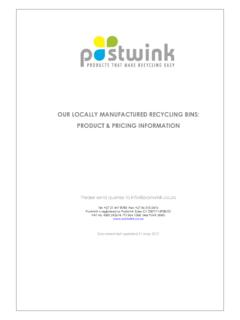Transcription of POPs in hazardous waste incineration
1 pops in hazardous waste incineration Prof. Dr. C. Vandecasteele, Dr. J. Van CaneghemUniversity of Leuven, Department of Chemical Engineering, Willem de Croylaan 46, B-3001 Leuven, BelgiumIntroductionPersistent Organic Pollutants ( pops ) are toxic organic chemicals. Due to a combination of their physical and chemical properties, after release into the environment, they remain intact for exceptionally long periods of time (many years); become widely distributed throughout the environment (soil, water and, most notably, air); accumulate in the fatty tissue of living organisms including humans, so that they are found at higher concentrations in organisms higher in the food effects of pops can include cancer, allergies and damage to the central and peripheral nervous systems. Some pops are endocrine disruptors, meaning that they affect systems in the human body that are controlled by hormones. In this way, they can cause sexual development problems, brain development problems, feminizing of males etc.
2 Because cell growth and differentiation during the development of a foetus is regulated by hormones, a foetus is very sensitive to chemicals that affect the hormonal balances. Therefore, doses of endocrine disruptors that have no effect on the mother can cause severe birth Stockholm Convention, which was adopted in 2001 and entered into force in 2004, is relative to the release of pops into the environment. Initially the convention considered twelve pesticides and industrial chemicals; in 2009 nine new chemicals were added. To date five other chemicals, including chlorinated naphthalenes and pentachlorophenol, are under review for addition to the list. Parties that ratified the convention must take measures to eliminate the production and use (Annex A) of the pesticides aldrin, chlordane, chlordecone, dieldrin, endrin, heptachlor, hexachlorobenzene (HCB), hexachlorocyclohexane ( -, - and lindane), mirex, pentachlorobenzene, toxaphene and the industrial chemicals polychlorinated biphenyls (PCBs), hexabromobiphenyl, and tetra-, penta-, hexa-, and heptabromodiphenylether; restrict the production and use (Annex B) of the pesticide DDT and the industrial chemicals perfluoro-octane sulfonic acid and its salts and perfluoro-octane sulfonyl fluoride; reduce the unintentional release of the following chemicals (Annex C): polychlorinated dibenzo-p-dioxins (PCDDs), polychlorinated dibenzofurans (PCDFs), hexachlorobenzene (HCB), pentachlorobenzene and polychlorinated biphenyls (PCBs).
3 Besides the chemicals listed by the Stockholm convention, many other substances released to the environment have persistent characteristics. Examples are unintentionally formed polybrominated dibenzo-p-dioxins, polybrominated dibenzofurans (PBDD/Fs) and phtalates (used as plasticiser).Figure 1 gives structural formulae of some important pops . 1 9687O102314O5 ClClClCl 2,3,7,8-tetrachloro-dibenzodioxin9687231 4O5 ClClClCl 1,3,6,9-tetrachloro-dibenzofuranCH2 CCl3 ClCl p-p -DDTClClClClClClOHH DieldrinClClClClClCl Hexachlorobenzene12534O103'4'2'5'1'6'BrB rBrBr 3,4,3 ,4 -tetrabromodiphenylether Figure 1. Structural formulae of some POPsSources of POPsChlorinated pesticides were used worldwide as insecticides until the mid-1970s, when their production and use was banned in most countries. Because of their persistence, humans are still exposed to them, mainly by eating fish, meat and dairy, which contain relatively high amounts of fat (Crinnion, 2009). In a study conducted in Texas, USA, p,p-DEE (a persistent metabolite of p,p-DDT, which is the most ubiquitous chlorinated pesticide (metabolite)) was found in the blood serum of of the examined individuals (Crinnion, 2009).
4 This could be related to the fact that DDT is an annex B POP and can still be used for disease vector control. Although the production and use of POP pesticides was stopped more than 30 years ago, important stocks remain, especially in the former USSR (241 000 ton), Africa (27 400 ton), Latin America (11 300 ton), Asia (6 500 ton) and in the Near East (4 500 ton) (FAO website). FAO, the Food and Agriculture Organization of the United Nations, indicates that currently the only available technology for the destruction of most obsolete pesticides is dedicated high temperature incineration (FAO website).PCBs were produced between 1929 and the mid-1980s, mainly in North America and Europe. The total global production of PCBs is estimated at million ton (Breivek et al., 2007).They were used as dielectric fluids in transformers and capacitors (closed applications) and in open applications such as ink and lubricants. Although the production of PCBs was stopped more than 20 years ago, closed applications are still the main source of PCBs to the environment.
5 Industrial thermal processes involving carbon and chlorine and incineration of waste (containing PCBs or not), are considered less important sources (Van Gerven et al., 2004). Breivek et al. (2007) estimated the global cumulative PCB emission from 1930 to 2005 at to 12% of the total PCB production. Food, more specifically fish, meat and dairy, is the major (> 90%) contributor to humane intake of PCBs (ATSDR, 2000).PCDD/Fs were never produced intentionally as marketable products, but originate as unwanted 2 byproducts of industrial and thermal processes. PCDD/Fs are for example formed as an unwanted byproduct in the production of chlorinated phenols. The well-known Seveso incident in 1976 is an example of unintentional release of large amounts of PCDD/Fs. Due to an accident in a trichlorophenol production plant, a chemical cloud containing several kg of the most toxic dioxin 2,3,7,8-tetraCDD was released, directly intoxicating more than 5000 people and contaminating soil and buildings in an area of 90 ha around the plant (Hites, 2011).
6 Besides the production of chlorinated chemicals, also thermal industrial processes, including coal fired power generation, ferrous and non-ferrous metal production, and waste incineration are known sources of PCDD/Fs. The formation of PCDD/Fs takes place at temperatures between 200 and 600 C. Two main formation routes have been proposed in literature: precursor condensation and de novo synthesis, as shown in Figure 2 (Altarawneh et al., 2009). A solid matrix such as a fine dust particle and a metal catalyst (typically Cu or one of its salts) are crucial for (heterogeneous) PCDD/F formation. In the precursor mechanism two precursor molecules such as chlorinated phenols and/or chlorinated benzenes combine to form PCDD/Fs. In de novo synthesis, PCDD/Fs are formed through the breakdown of a carbon matrix in a series of oxidation and chlorination steps (Everaert and Baeyens, 2002; Altarawneh et al., 2009).Disposal options for pops and POP-containing wasteThe two main disposal options for pops landfilling and incineration are discussed in this paragraph.
7 Furthermore attention is given to the fate of pops during recycling of POP containing goods such as waste of electrical and electronic equipment (WEEE). pops in landfillsIn a recent review, Weber et al. (2011) illustrate that historically pops were dumped in often badly engineered and unsustainably located landfill sites and dumps. Only a small percentage of the PCBs has been destroyed; between 13 and 17% is still in use in transformers and capacitors, and most of the remainder has been sent to landfills. In these landfills they may eventually leach or volatilize, thus contaminating the environment and entering the food chain. A landfill that was regularly flooded accidentally and contained approximately 20 ton of PCBs distributed in capacitors was found to be the main contamination source for fish in the Saane River, Switserland. Also POP pesticides have been and are sometimes disposed in inadequate landfills. In Poland , ten thousand ton of POP pesticides were buried in underground cemeteries and there is increasing evidence of groundwater contamination and of elevated concentrations of pesticides in the air around these landfills.
8 Because of the long-term persistence of pops , with half-lives of 100 years and beyond, also engineered landfills do not guarantee they will contain these persistent pollutants: liners and gas and leachate collection systems may degrade long before the pops in the landfill are destroyed. The costs of the landfill aftercare required to protect the environment and humans from the toxic effects of pops are enormous. Weber et al. (2011) conclude that pops and other persistent toxic substances should not be deposited, but destroyed and that existing critical landfills are most likely to require and recyclingAccording to the EU waste hierarchy, recycling of materials is in general to be preferred over incineration with energy recovery. However, in wastes containing pops or contaminated with pops , the fate of these should be considered, mainly for health and safety reasons. During recycling pops are often not destroyed and can accumulate or dissipate in the environment and eventually do harm to people.
9 This is illustrated here for a few recycling techniques applied in Europe or in the rest of the world. Rideout and Teschke (2004) reviewed the fate of PCDD/Fs in municipal wastewater treatment sludge recycled as fertilizer on arable land. They concluded that repeated application of sludge on lands to graze cattle likely results in increased human exposure to PCDD/Fs through consumption of dairy-products and meat. Another example is recycling of plastics and printed circuit boards from electrical and electronic equipment. These components can contain high concentrations of brominated flame retarands (BFRs) including polybrominated diphenyl ethers (PBDE) (Figure 1), which are contaminated with or can act as precursor for polybrominated di-benzodioxins and furans (PBDD/Fs). In Europe, directive 2002/96/EC sets targets for the recovery, reuse and recycling of 3 different WEEE categories and imposes the selective removal before recycling of PCB-containing components, of printed circuit boards (> 10 dm ) and of BFR-containing plastics .
10 However, in often rudimentary facilities for WEEE recycling in developing countries, including South-east Asia, India and China, valuable metals such as copper and tin are recovered by burning printed circuit boards with supplementary fuel in open fires. In these fires, the conditions (T, O2, C, metal catalysts, Cl and Br) for formation and release of pops are met. This is confirmed by numerous recent studies reporting high concentrations of PCDD/Fs, PBDD/Fs, PCBs and PBDEs in air, soil and house dust in rudimentary WEEE recycling facilities (Tue et al., 2010; Ma et al., 2009; Gullet et al., 2007) and high concentrations of PCDD/Fs, PCBs and PBDEs in hair and cord blood samples of workers in facilities for WEEE recycling in China (Zhang et al., 2010; Ma et al., 2011). OHClOCu(I)OHClOHOCu(I)OCl- HClOOCu(I)O- HClOOdesorptionchlorination (and desorption)ClxOClyOOCu(I) Figure 2: Proposed Eley-Rideal mechanism for PCDD formation through precursor condensation Destruction of pops in hazardous waste incinerationA hazardous waste mix for incineration in a dedicated waste incinerator may partly consist of annex A pops , PCB oils from dismantled transformers and chlorinated pesticides, and/or may contain wastes contaminated with pops , activated carbon filters used for flue gas cleaning in combustion installations, and industrial sludge.





